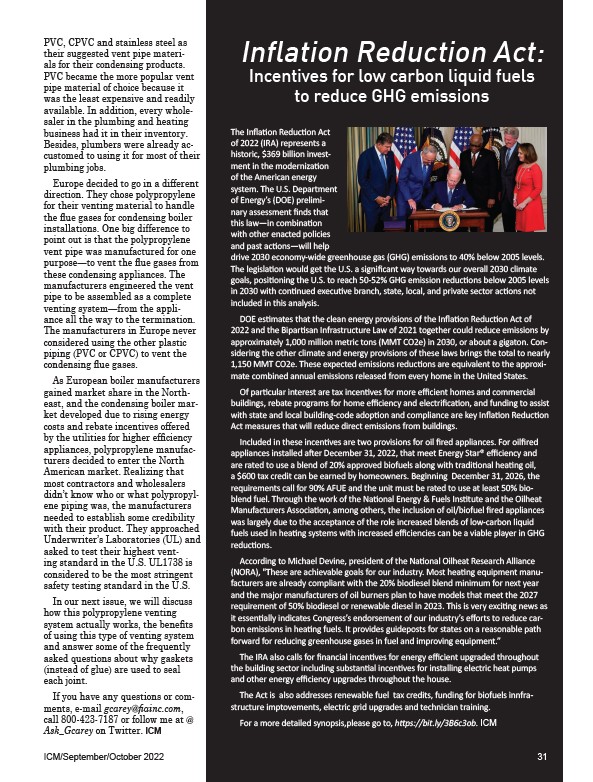
The Inflation Reduction Act
of 2022 (IRA) represents a
historic, $369 billion investment
in the modernization
of the American energy
system. The U.S. Department
of Energy’s (DOE) preliminary
assessment finds that
this law—in combination
with other enacted policies
and past actions—will help
drive 2030 economy-wide greenhouse gas (GHG) emissions to 40% below 2005 levels.
The legislation would get the U.S. a significant way towards our overall 2030 climate
goals, positioning the U.S. to reach 50-52% GHG emission reductions below 2005 levels
in 2030 with continued executive branch, state, local, and private sector actions not
included in this analysis.
DOE estimates that the clean energy provisions of the Inflation Reduction Act of
2022 and the Bipartisan Infrastructure Law of 2021 together could reduce emissions by
approximately 1,000 million metric tons (MMT CO2e) in 2030, or about a gigaton. Considering
the other climate and energy provisions of these laws brings the total to nearly
1,150 MMT CO2e. These expected emissions reductions are equivalent to the approximate
combined annual emissions released from every home in the United States.
Of particular interest are tax incentives for more efficient homes and commercial
buildings, rebate programs for home efficiency and electrification, and funding to assist
with state and local building-code adoption and compliance are key Inflation Reduction
Act measures that will reduce direct emissions from buildings.
Included in these incentives are two provisions for oil fired appliances. For oilfired
appliances installed after December 31, 2022, that meet Energy Star® efficiency and
are rated to use a blend of 20% approved biofuels along with traditional heating oil,
a $600 tax credit can be earned by homeowners. Beginning December 31, 2026, the
requirements call for 90% AFUE and the unit must be rated to use at least 50% bioblend
fuel. Through the work of the National Energy & Fuels Institute and the Oilheat
Manufacturers Association, among others, the inclusion of oil/biofuel fired appliances
was largely due to the acceptance of the role increased blends of low-carbon liquid
fuels used in heating systems with increased efficiencies can be a viable player in GHG
reductions.
According to Michael Devine, president of the National Oilheat Research Alliance
(NORA), "These are achievable goals for our industry. Most heating equipment manufacturers
are already compliant with the 20% biodiesel blend minimum for next year
and the major manufacturers of oil burners plan to have models that meet the 2027
requirement of 50% biodiesel or renewable diesel in 2023. This is very exciting news as
it essentially indicates Congress’s endorsement of our industry’s efforts to reduce carbon
emissions in heating fuels. It provides guideposts for states on a reasonable path
forward for reducing greenhouse gases in fuel and improving equipment.”
The IRA also calls for financial incentives for energy efficient upgraded throughout
the building sector including substantial incentives for installing electric heat pumps
and other energy efficiency upgrades throughout the house.
The Act is also addresses renewable fuel tax credits, funding for biofuels innfrastructure
imptovements, electric grid upgrades and technician training.
For a more detailed synopsis,please go to, https://bit.ly/3B6c3ob. ICM
PVC, CPVC and stainless steel as
their suggested vent pipe materials
for their condensing products.
PVC became the more popular vent
pipe material of choice because it
was the least expensive and readily
available. In addition, every wholesaler
in the plumbing and heating
business had it in their inventory.
Besides, plumbers were already accustomed
to using it for most of their
plumbing jobs.
Europe decided to go in a different
direction. They chose polypropylene
for their venting material to handle
the flue gases for condensing boiler
installations. One big difference to
point out is that the polypropylene
vent pipe was manufactured for one
purpose—to vent the flue gases from
these condensing appliances. The
manufacturers engineered the vent
pipe to be assembled as a complete
venting system—from the appliance
all the way to the termination.
The manufacturers in Europe never
considered using the other plastic
piping (PVC or CPVC) to vent the
condensing flue gases.
As European boiler manufacturers
gained market share in the Northeast,
and the condensing boiler market
developed due to rising energy
costs and rebate incentives offered
by the utilities for higher efficiency
appliances, polypropylene manufacturers
decided to enter the North
American market. Realizing that
most contractors and wholesalers
didn’t know who or what polypropylene
piping was, the manufacturers
needed to establish some credibility
with their product. They approached
Underwriter’s Laboratories (UL) and
asked to test their highest venting
standard in the U.S. UL1738 is
considered to be the most stringent
safety testing standard in the U.S.
In our next issue, we will discuss
how this polypropylene venting
system actually works, the benefits
of using this type of venting system
and answer some of the frequently
asked questions about why gaskets
(instead of glue) are used to seal
each joint.
If you have any questions or comments,
e-mail gcarey@fiainc.com,
call 800-423-7187 or follow me at @
Ask_Gcarey on Twitter. ICM
Inflation Reduction Act:
Incentives for low carbon liquid fuels
to reduce GHG emissions
ICM/September/October 2022 31